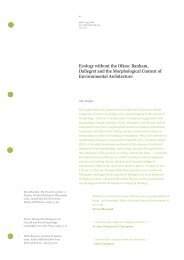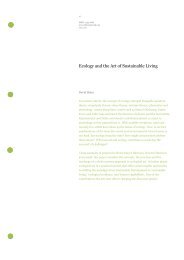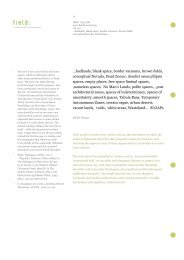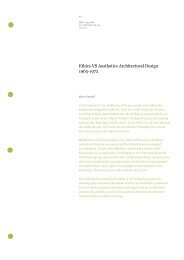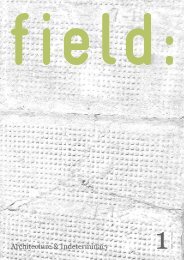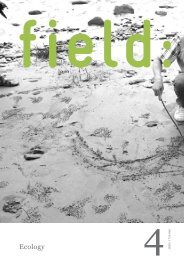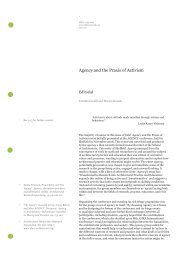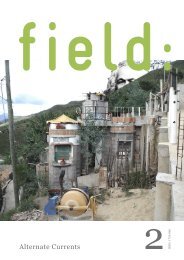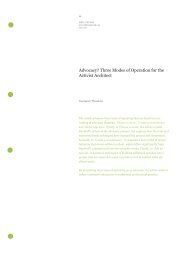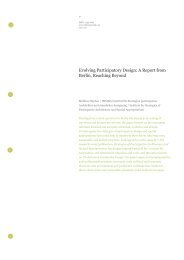A quick conversation about the theory and practice of ... - field journal
A quick conversation about the theory and practice of ... - field journal
A quick conversation about the theory and practice of ... - field journal
You also want an ePaper? Increase the reach of your titles
YUMPU automatically turns print PDFs into web optimized ePapers that Google loves.
136<br />
ISSN: 1755-068<br />
www.<strong>field</strong>-<strong>journal</strong>.org<br />
vol.1 (1)<br />
A <strong>quick</strong> <strong>conversation</strong> <strong>about</strong> architecture<br />
A <strong>quick</strong> <strong>conversation</strong> <strong>about</strong> <strong>the</strong> <strong>the</strong>ory <strong>and</strong><br />
<strong>practice</strong> <strong>of</strong> control, authorship <strong>and</strong> creativity in<br />
architecture<br />
Kim Trogal & Leo Care<br />
In mainstream architectural <strong>practice</strong> in <strong>the</strong> UK, we find that most<br />
architects are largely concerned with <strong>the</strong> issues <strong>of</strong> ‘determination’ <strong>and</strong><br />
‘definition’. At each stage <strong>of</strong> <strong>the</strong> process aspects <strong>of</strong> <strong>the</strong> project become<br />
increasingly identified, categorised <strong>and</strong> specified. In this context<br />
indeterminacy is a negative term, synonymous with weakness; understood<br />
as creating a risk for <strong>the</strong> legal, financial <strong>and</strong> pr<strong>of</strong>essional position <strong>of</strong> <strong>the</strong><br />
individual. As such, architects seek to eradicate indeterminacy from <strong>the</strong>ir<br />
work.<br />
The adoption <strong>of</strong> certain tools <strong>and</strong> processes serve to limit <strong>and</strong> fix aspects<br />
<strong>of</strong> <strong>the</strong> project <strong>and</strong> <strong>the</strong> nature <strong>of</strong> <strong>the</strong> relationships that create it. We suggest<br />
that <strong>the</strong>se processes are adopted within a particular <strong>and</strong> established<br />
context that <strong>of</strong>ten escapes questioning. It is to this we turn our attention,<br />
<strong>and</strong> through <strong>the</strong> form <strong>of</strong> dialogue, we examine critically some <strong>of</strong> <strong>the</strong> tools<br />
<strong>and</strong> languages <strong>of</strong> traditional <strong>practice</strong> <strong>and</strong> suggest some alternatives.
1 Andrea Kahn ‘The Invisible Mask’, in<br />
Andrea Kahn (ed.) Drawing, Building<br />
Text: Essays in Architectural Theory<br />
(New York: Princeton Architectural<br />
Press, 1991), pp. 85-106.<br />
137<br />
www.<strong>field</strong>-<strong>journal</strong>.org<br />
vol.1 (1)<br />
A <strong>quick</strong> <strong>conversation</strong> <strong>about</strong> architecture<br />
Foreword<br />
At <strong>the</strong> conference from which this publication developed, our intention<br />
was to encourage our student audience to consider what <strong>the</strong> topic <strong>of</strong><br />
<strong>the</strong> conference might mean for <strong>the</strong>m as future practicing architects. We<br />
wanted to use <strong>the</strong> opportunity to pose <strong>the</strong> question, both to ourselves<br />
<strong>and</strong> to our audience, ‘How might ideas <strong>of</strong> indeterminacy alter how we<br />
go abut practicing architecture?’ Through our <strong>conversation</strong>, we wanted<br />
to emphasise that <strong>the</strong> work presented by speakers should not be taken<br />
as isolated <strong>the</strong>ory that is abstractly ‘applied’ to <strong>practice</strong>, ra<strong>the</strong>r it should<br />
be understood as something that can transform our way <strong>of</strong> thinking<br />
<strong>and</strong> working. By reflecting on our recent experiences <strong>and</strong> questioning<br />
established processes in <strong>practice</strong>, we wanted to use <strong>the</strong> opportunity to<br />
think <strong>about</strong> how we might begin to <strong>practice</strong> differently.<br />
We approached <strong>the</strong> conference from two differing personal positions.<br />
Having shared our architectural education toge<strong>the</strong>r at Shef<strong>field</strong> University<br />
a few years ago, we have each worked for different architects, but shared<br />
similar concerns over our modes <strong>of</strong> <strong>practice</strong>; in search <strong>of</strong> something more<br />
ethical, transforming <strong>and</strong> creative. In <strong>the</strong> last year, Leo has completed <strong>the</strong><br />
pr<strong>of</strong>essional <strong>practice</strong> course (Part 3) <strong>and</strong> Kim has begun a research degree<br />
(PhD). We were interested in allowing <strong>the</strong>se contrasting experiences to<br />
meet in an informal <strong>and</strong> inquisitive way, over our shared concerns. We<br />
were <strong>the</strong> final speakers <strong>of</strong> <strong>the</strong> day <strong>and</strong> so in this position we chose to begin<br />
a dialogue, to initiate questioning <strong>and</strong> debate; specifically around <strong>the</strong><br />
political potential <strong>of</strong> indeterminacy in relation to how we go <strong>about</strong> doing<br />
things as architects.<br />
In <strong>the</strong> introduction to her essay, ‘The Invisible Mask’, Andrea Khan argues<br />
that architecture ‘divides, organises <strong>and</strong> manages’ <strong>and</strong> as such constitutes<br />
a form <strong>of</strong> control <strong>and</strong> power. This she argues is achieved through<br />
enclosure, that is to say, through <strong>the</strong> delineation <strong>of</strong> particular spaces for<br />
particular uses <strong>and</strong> this she argues, is ‘<strong>the</strong> political nature <strong>of</strong> architecture’. 1<br />
In a similar way, we might view that within <strong>the</strong> architectural <strong>field</strong>,<br />
intellectual property <strong>and</strong> knowledge is defined <strong>and</strong> maintained through<br />
<strong>the</strong> establishment <strong>of</strong> different boundaries within <strong>the</strong> process. As <strong>the</strong><br />
delineation <strong>of</strong> spaces for particular uses constitutes a form <strong>of</strong> control, so<br />
does <strong>the</strong> delineation <strong>of</strong> various activities <strong>and</strong> duties, by specific groups or<br />
individuals, within a process. This delineation is a means <strong>of</strong> controlling <strong>the</strong><br />
process <strong>and</strong> hence invariably leads to a control <strong>of</strong> its architectural product.<br />
This is also <strong>the</strong>n, part <strong>of</strong> <strong>the</strong> ‘political nature <strong>of</strong> architecture’.
2 Ka<strong>the</strong>rine Shon<strong>field</strong>, ‘The Use <strong>of</strong> Fiction<br />
to Reinterpret Architectural <strong>and</strong> Urban<br />
Space’ in Iain Borden <strong>and</strong> Jane Rendell<br />
(eds.) Intersections: Architectural<br />
Histories <strong>and</strong> Critical Theories<br />
(London: Routledge, 2000), p. 310.<br />
3 Jeremy Till, ‘Five Questions for<br />
Architectural Education’ paper<br />
presented to <strong>the</strong> RIBA, UK (1997).<br />
138<br />
www.<strong>field</strong>-<strong>journal</strong>.org<br />
vol.1 (1)<br />
A <strong>quick</strong> <strong>conversation</strong> <strong>about</strong> architecture<br />
Along similar lines, <strong>and</strong> following <strong>the</strong> work <strong>of</strong> David Harvey, Ka<strong>the</strong>rine<br />
Shon<strong>field</strong> connects <strong>the</strong> fixed delineation <strong>of</strong> space, architecture <strong>and</strong> its<br />
associated process directly to <strong>the</strong> development <strong>of</strong> capitalism. She writes:<br />
The regular delineation <strong>of</strong> space — whe<strong>the</strong>r at <strong>the</strong> micro scale <strong>of</strong> a<br />
component, as in <strong>the</strong> post war building industry, or at <strong>the</strong> macro<br />
scale <strong>of</strong> <strong>the</strong> city — smoo<strong>the</strong>s <strong>the</strong> way to <strong>the</strong> commodification <strong>of</strong> space<br />
allowing it to be bought or sold as o<strong>the</strong>r products. 2<br />
Again, we can extend this argument to consider architecture’s associated<br />
processes, <strong>and</strong> it is here that tension arises between architectural<br />
education, training <strong>and</strong> <strong>the</strong> pr<strong>of</strong>ession. Jeremy Till has written:<br />
There is a familiar complaint from <strong>the</strong> architectural pr<strong>of</strong>ession<br />
<strong>about</strong> architectural education: ‘You are not preparing students for<br />
<strong>practice</strong>’ to which I reply ‘which <strong>practice</strong>?’ Underlying <strong>the</strong> question<br />
is an assumption that <strong>the</strong>re is a single model <strong>of</strong> <strong>practice</strong> to which <strong>the</strong><br />
pr<strong>of</strong>ession aspires <strong>and</strong> it is <strong>the</strong> task <strong>of</strong> education to supply students who<br />
will passively serve <strong>and</strong> support this model. 3<br />
In our dialogue. we wanted to suggest that <strong>the</strong> delineation <strong>of</strong> architectural<br />
education is also a significant issue, <strong>and</strong> that <strong>the</strong> Part 3 course serves as<br />
pr<strong>of</strong>essional training at <strong>the</strong> expense <strong>of</strong> a more critical <strong>practice</strong>. By taking<br />
indeterminacy as a specific example, we wanted to highlight <strong>the</strong> division <strong>of</strong><br />
<strong>the</strong>ory <strong>and</strong> <strong>practice</strong> in architectural pedagogical structures, <strong>and</strong> moreover<br />
to suggest indeterminacy has a radical implication for architectural<br />
processes, education <strong>and</strong> our ideas <strong>of</strong> pr<strong>of</strong>essionalism. By discussing our<br />
own experiences <strong>of</strong> education <strong>and</strong> <strong>the</strong> pr<strong>of</strong>ession, we wanted to highlight<br />
how indeterminacy in architectural processes is perceived as a weakness<br />
ra<strong>the</strong>r than a potential strength. In fact in this context, indeterminacy<br />
is something that we as architects usually try to rid ourselves <strong>of</strong> as we<br />
continually seek to define aspects <strong>of</strong> a project. Indeterminacy is seen as a<br />
risk <strong>and</strong> increasingly so as a project develops.<br />
The mechanisms <strong>and</strong> tools we develop as architects, generally reflect<br />
<strong>the</strong> idea that indeterminacy is a weakness. The formal delineation <strong>and</strong><br />
determination <strong>of</strong> architectural processes, acts to control cost, design<br />
authorship <strong>and</strong> built quality <strong>of</strong> a building. In this arena, indeterminacy is<br />
understood to create a risk to <strong>the</strong> legal, financial <strong>and</strong> pr<strong>of</strong>essional position<br />
<strong>of</strong> <strong>the</strong> individual. As such, architects adopt st<strong>and</strong>ard tools <strong>and</strong> processes to<br />
safeguard <strong>the</strong>mselves, <strong>and</strong> thus seek to eradicate indeterminacy from <strong>the</strong>ir<br />
work. Francesca Hughes writes:<br />
We go to great lengths to both separate ourselves from <strong>and</strong> control<br />
<strong>the</strong> act <strong>of</strong> making buildings. These lengths, <strong>the</strong> production <strong>of</strong> complex<br />
documentation in order to direct construction by o<strong>the</strong>rs… define <strong>the</strong><br />
architect […] like all forms <strong>of</strong> discipline, <strong>the</strong> less effective it is, <strong>the</strong> more
4 Francesca Hughes, ‘Stabat Mater:<br />
on st<strong>and</strong>ing in for matter’ in Doina<br />
Petrescu (ed.) Altering Practices:<br />
Feminine Politics <strong>and</strong> Poetics <strong>of</strong> Space<br />
(London: Routledge, 2007), p. 267.<br />
5 Katie Lloyd Thomas has drawn a<br />
connection between <strong>the</strong> establishment<br />
<strong>of</strong> particular architectural drawings in<br />
<strong>the</strong> process <strong>and</strong> <strong>the</strong>ir connection to <strong>the</strong><br />
pr<strong>of</strong>ession. She writes: ‘Although it is<br />
<strong>of</strong>ten said that architectural drawings<br />
allows communication between <strong>the</strong><br />
architect <strong>and</strong> <strong>the</strong> builder, historically<br />
it has produced a separation […] The<br />
st<strong>and</strong>ardisation <strong>of</strong> architectural drawing<br />
[…] coincides with <strong>the</strong> emergence <strong>of</strong><br />
<strong>the</strong> pr<strong>of</strong>ession.’ Katie Lloyd Thomas<br />
‘Building While Being In It: Notes<br />
on drawing “o<strong>the</strong>rhow”’, in Petrescu<br />
(ed.) Altering Practices, pp. 89-112.<br />
6 In <strong>the</strong> UK, <strong>the</strong> title ‘Architect’ is<br />
legally protected, for which <strong>the</strong> Part<br />
3 qualification is a legal requirement:<br />
you cannot call yourself an architect<br />
without it. Currently, ‘Part 2’ is a<br />
postgraduate course, usually 2 years<br />
full-time accredited by <strong>the</strong> RIBA (Royal<br />
Institute <strong>of</strong> British Architects). ‘Part 3’<br />
also refers to <strong>the</strong> pr<strong>of</strong>essional <strong>practice</strong><br />
course, usually a part-time course<br />
undertaken over a year at a University,<br />
whilst <strong>the</strong> student is in full-time<br />
employment in an architectural <strong>practice</strong>.<br />
7 Jeremy Till, ‘Architecture <strong>and</strong><br />
Contingency’, <strong>field</strong>:, 1(1) (2007): 124-140.<br />
139<br />
www.<strong>field</strong>-<strong>journal</strong>.org<br />
vol.1 (1)<br />
A <strong>quick</strong> <strong>conversation</strong> <strong>about</strong> architecture<br />
excessively it is employed <strong>and</strong> <strong>the</strong> more unbending, frequent <strong>and</strong><br />
extreme its application is likely to be. 4<br />
At each stage <strong>of</strong> <strong>the</strong> process, be it development <strong>of</strong> <strong>the</strong> brief, initial designs<br />
or <strong>the</strong> production <strong>of</strong> working drawings, aspects <strong>of</strong> <strong>the</strong> project become<br />
increasingly identified, categorised <strong>and</strong> specified. The tools employed<br />
by architects in <strong>practice</strong> within this process, such as <strong>the</strong> RIBA stages <strong>of</strong><br />
work, <strong>the</strong> establishment <strong>of</strong> tender processes <strong>and</strong> <strong>the</strong> adoption <strong>of</strong> st<strong>and</strong>ard<br />
contracts, serve to limit <strong>and</strong> fix aspects <strong>of</strong> <strong>the</strong> project <strong>and</strong> <strong>the</strong> nature <strong>of</strong> <strong>the</strong><br />
relationships it takes to create it.<br />
The tools adopted by <strong>practice</strong> are chosen within a particular <strong>and</strong><br />
established economic <strong>and</strong> political context, <strong>and</strong> it is precisely this context<br />
we sought to question here. We wanted to emphasise that to work with<br />
indeterminacy requires new tools, new ways <strong>of</strong> working <strong>and</strong> ultimately<br />
requires a rethinking our pr<strong>of</strong>essional roles. 5 We began with <strong>the</strong> premise<br />
that ra<strong>the</strong>r than posing a risk to <strong>practice</strong>, indeterminacy is essential in<br />
creative processes. We felt that in order to be creative, we need to be<br />
open to things, places <strong>and</strong> people. In considering indeterminacy <strong>and</strong><br />
architectural processes, we associate indeterminacy with openness <strong>and</strong><br />
generosity to o<strong>the</strong>rs.<br />
We felt that if we, <strong>and</strong> our audience, were to take <strong>the</strong> ideas <strong>of</strong> <strong>the</strong><br />
conference into our working lives we will have to learn to make space for<br />
it.<br />
Kim Trogal: Leo, after 10 years, you are now <strong>of</strong>ficially a fully qualified architect. Con-<br />
gratulations. To reflect on our experiences, I have <strong>the</strong> feeling that in <strong>the</strong> UK we are stuck<br />
with <strong>the</strong> idea that part 2 is ‘<strong>about</strong> <strong>the</strong>ory’, <strong>and</strong> <strong>the</strong>refore irrelevant to <strong>practice</strong>, but part<br />
3 is something completely different; it’s ‘<strong>about</strong> <strong>practice</strong>’ <strong>and</strong> <strong>the</strong>refore irrelevant to <strong>the</strong> rest<br />
<strong>of</strong> <strong>the</strong> school <strong>of</strong> architecture. 6 And so it constructs <strong>the</strong> idea that <strong>the</strong>ory <strong>and</strong> <strong>practice</strong> are<br />
divorced from each o<strong>the</strong>r. Do you feel your experience reflects this?<br />
Leo Care: To help me answer that I had a small diagram, which was very crude, but<br />
it was essentially somebody stood at <strong>the</strong> beginning <strong>of</strong> a series <strong>of</strong> paths <strong>and</strong> that was to<br />
try to represent how this course –– <strong>the</strong> Part 2 course –– is all <strong>about</strong> finding your own<br />
way; its <strong>about</strong> people <strong>of</strong>fering you opportunities. Situations arise <strong>and</strong> you choose to<br />
follow, to explore different avenues. My feeling doing <strong>the</strong> part 3 course, was that all<br />
those avenues that had opened up to you suddenly converged; <strong>the</strong>y came toge<strong>the</strong>r to<br />
form a single route that you had to go down. So, in a sense <strong>the</strong> possibility <strong>of</strong> making<br />
space for indeterminacy was completely taken away from you. I think this goes back<br />
to what Jeremy 7 said this morning, <strong>about</strong> <strong>the</strong> pr<strong>of</strong>ession <strong>and</strong> architects yearning for<br />
simplicity <strong>and</strong> not opening our eyes to <strong>the</strong> muckiness <strong>of</strong> life, or affording people <strong>the</strong><br />
chance to look more openly at situations.
140<br />
www.<strong>field</strong>-<strong>journal</strong>.org<br />
vol.1 (1)<br />
A <strong>quick</strong> <strong>conversation</strong> <strong>about</strong> architecture<br />
KT: Do you think <strong>the</strong> Part 3 course reflects a view that indeterminacy is synonymous with<br />
weakness? Or that it cannot accept indeterminacy in <strong>practice</strong>?<br />
LC: Yes. I think it does. The Part 3 course is all <strong>about</strong> learning a set <strong>of</strong> protocols. It’s<br />
<strong>about</strong> learning <strong>the</strong> way that you should work <strong>and</strong> that is a very established way <strong>of</strong><br />
working in <strong>practice</strong>. The course doesn’t recognise different ways <strong>of</strong> working; it is very<br />
set <strong>and</strong> very linear. I found that very difficult to cope with; <strong>the</strong>re not being <strong>the</strong> op-<br />
portunity to try different things or explore different possibilities.<br />
KT: Maybe we can talk <strong>about</strong> <strong>the</strong> dreaded log sheets? (Fig. 1). They raise questions <strong>about</strong><br />
<strong>the</strong> way we categorise <strong>and</strong> regulate our experience. I don’t know <strong>about</strong> you, but I would<br />
say a lot <strong>of</strong> my experience doesn’t fit with those forms. The forms had a series <strong>of</strong> categories<br />
that break down <strong>the</strong> process <strong>of</strong> how you go <strong>about</strong> doing an architectural project.<br />
LC: There are 26 categories <strong>and</strong> <strong>the</strong>n four blank stages at <strong>the</strong> end. It’s a linear process,<br />
a very defined package <strong>of</strong> things, with boxes you’ve got to tick <strong>of</strong>f to prove that you’ve<br />
had enough experience, <strong>and</strong> <strong>the</strong> four little segments at <strong>the</strong> bottom that you are al-<br />
lowed to fill in are your only chance to express something.<br />
Fig.1. Kim’s sample Practical Training<br />
Log Sheet. Image: Kim Trogal.
8 Diagram <strong>of</strong><br />
‘chora’; Kim Trogal.<br />
9 ‘For Plato, chora is that which, lacking<br />
any substance or identity <strong>of</strong> its own,<br />
falls between <strong>the</strong> ideal <strong>and</strong> <strong>the</strong> material;<br />
it is <strong>the</strong> receptacle or nurse that brings<br />
material into being, without being<br />
material […] <strong>the</strong> space <strong>of</strong> <strong>the</strong> in between is<br />
that which is not a space, a space without<br />
boundaries <strong>of</strong> its own […] The space <strong>of</strong> <strong>the</strong><br />
in between is <strong>the</strong> locus for social, cultural<br />
<strong>and</strong> natural transformations.’ Elizabeth<br />
Grosz, Architecture from <strong>the</strong> Outside:<br />
Essays in Virtual <strong>and</strong> Real Space<br />
(London: MIT Press, 2002), pp. 91-92.<br />
10 Till, ‘Architecture <strong>and</strong> Contingency’.<br />
11 See also Kim Trogal, ‘Open Kitchen’ in<br />
Doina Petrescu (ed.) Altering Practices:<br />
Feminine Politics <strong>and</strong> Poetics <strong>of</strong> Space<br />
(London: Routledge, 2007), pp. 167-188.<br />
141<br />
www.<strong>field</strong>-<strong>journal</strong>.org<br />
vol.1 (1)<br />
A <strong>quick</strong> <strong>conversation</strong> <strong>about</strong> architecture<br />
KT: The fact that <strong>the</strong>y’re at <strong>the</strong> end … implies <strong>the</strong>y’re not related to any <strong>of</strong> <strong>the</strong> o<strong>the</strong>r stages.<br />
I used to work for a <strong>practice</strong> called ‘fluid’ <strong>and</strong> I would say much <strong>of</strong> my experience <strong>the</strong>re<br />
would not be considered, lets say ‘valid’, in terms <strong>of</strong> that way <strong>of</strong> measuring <strong>and</strong> assessing<br />
your experience. I was looking at masterplanning for areas that required regeneration,<br />
where you design <strong>the</strong> brief for <strong>the</strong> project <strong>and</strong> <strong>the</strong> proposal with members <strong>of</strong> <strong>the</strong> com-<br />
munity. So a lot <strong>of</strong> my work was <strong>about</strong> designing a process ra<strong>the</strong>r than a thing; designing<br />
processes <strong>of</strong> research, <strong>of</strong> ways to work with people, or working on o<strong>the</strong>r more art-based<br />
projects. A lot <strong>of</strong> people would put that into a different category <strong>and</strong> say as a pr<strong>of</strong>ession its<br />
not part <strong>of</strong> our work. Yet we are architects doing <strong>the</strong>se things, <strong>and</strong> <strong>the</strong>re is no space for it<br />
on those forms — I would still call it architecture, part <strong>of</strong> architecture.<br />
Currently I work in a traditional private <strong>practice</strong>, <strong>and</strong> … I think what’s strikingly obvi-<br />
ous, is that <strong>the</strong>re is an attempt to establish everything in advance, to fix everything as<br />
<strong>quick</strong>ly as you can before you even know who’s going to build it with you … it shows <strong>the</strong><br />
desire in formal processes to avoid uncertainty …<br />
One thing I did was to draw a diagram, 8 that was a bit naïve to draw … <strong>about</strong> <strong>the</strong> idea<br />
<strong>of</strong> ‘chora’ from Plato, describing <strong>the</strong> relationship <strong>of</strong> ideas <strong>and</strong> matter; let’s say <strong>the</strong>ory <strong>and</strong><br />
<strong>practice</strong> <strong>and</strong> <strong>the</strong> relationship between <strong>the</strong> two. Between <strong>the</strong>se two he describes a space,<br />
which he calls ‘chora’ … <strong>the</strong> unbounded, undefined, limitless, formless, indeterminate<br />
space, <strong>the</strong> space in between <strong>the</strong>se two things, where you are moving from one to <strong>the</strong> o<strong>the</strong>r,<br />
<strong>and</strong> it is precisely in this space where things change, where things are transformed <strong>and</strong><br />
come into being. 9<br />
Alongside this, for effect, we place <strong>the</strong> RIBA stages <strong>of</strong> work. Stages A-L, where you have a<br />
completely linear process, where you move from idea to matter in one direction only <strong>and</strong><br />
at each stage you determine more <strong>and</strong> more what you are trying to do. Jeremy referred to<br />
an ordering tendency we have, <strong>and</strong> I think that applies to process as well as a desire to<br />
order physical space. 10 I’d suggest that <strong>the</strong> way to deal with contingency or indeterminacy<br />
is, for us at least, an issue <strong>of</strong> process. So at each stage you are determining things, but all in<br />
advance. As a model <strong>of</strong> working, it can’t accommodate participative processes very well, for<br />
instance.<br />
One project we did toge<strong>the</strong>r, when we were students, looked at language <strong>and</strong> architectural<br />
processes. We proposed a double analogy; we took a recipe for a cake <strong>and</strong> re-wrote it to<br />
read as a recipe for site-mixed concrete, <strong>and</strong> <strong>the</strong>n we took a part <strong>of</strong> <strong>the</strong> National Building<br />
Specification site work st<strong>and</strong>ards for concrete, <strong>and</strong> re-wrote <strong>the</strong>m to read as instructions for<br />
making a cake. We were trying to critique <strong>the</strong> language we use in industry, to show how<br />
abstract it is (<strong>and</strong> in places absurd) <strong>and</strong> that it assumes a certain process. The specification<br />
is a legally binding document from an architect to a contractor, <strong>and</strong> so by using that tool<br />
you are assuming <strong>and</strong> setting up, deliberately or o<strong>the</strong>rwise, a very particular relationship<br />
<strong>and</strong> a very particular way <strong>of</strong> working. So we thought that o<strong>the</strong>r forms <strong>of</strong> communication,<br />
like <strong>the</strong> recipe, can <strong>of</strong>fer <strong>the</strong> opportunity to leave gaps or openings, for people, for input on<br />
<strong>the</strong> side <strong>of</strong> <strong>the</strong> maker, or for someone o<strong>the</strong>r than <strong>the</strong> author or <strong>the</strong> architect. It incorporates<br />
indeterminacy. 11
142<br />
www.<strong>field</strong>-<strong>journal</strong>.org<br />
vol.1 (1)<br />
A <strong>quick</strong> <strong>conversation</strong> <strong>about</strong> architecture<br />
If you want to work with indeterminacy, you can’t readily use <strong>the</strong> existing tools <strong>and</strong> proc-<br />
esses <strong>of</strong> st<strong>and</strong>ard <strong>practice</strong>. You’ll need to radically alter <strong>the</strong>m or invent your own.<br />
Leo … do you find that you <strong>of</strong>ten have to invent new tools?<br />
LC: Yes, I just wanted to talk <strong>about</strong> a very small project that we undertook, to create<br />
a very modest piece <strong>of</strong> architecture essentially, which is a temporary youth shelter in<br />
a heritage park in Shef<strong>field</strong>. On this project, we tried to change <strong>the</strong> way that we work<br />
<strong>and</strong> <strong>the</strong> way we authored … <strong>the</strong> project in order to create space for o<strong>the</strong>r people to be<br />
involved, <strong>and</strong> we did that in a number <strong>of</strong> ways.<br />
Firstly, by working directly with people interested in using <strong>the</strong> youth shelter, which<br />
were local young people in <strong>the</strong> area. We went through a simple consultation process<br />
(Fig. 2) that involved actually building things, which I think is something people<br />
rarely do nowadays, young or old … Established systems <strong>of</strong> process can actually stop<br />
people being involved but its something we believe in. That’s <strong>the</strong> first stage.<br />
Fig.2. Abbey<strong>field</strong> Park Shelter Project, consultation. Image: Bureau <strong>of</strong> Design<br />
Research.<br />
Then, this project wasn’t to be built by a contractor but at <strong>the</strong> same time it had to<br />
conform to building regulations <strong>and</strong> pass planning approval as well. But we weren’t<br />
sure who was going to make <strong>and</strong> build <strong>the</strong> project <strong>and</strong> that’s something maybe we’re<br />
not used to in <strong>practice</strong>. The person who had commissioned <strong>the</strong> work was a park<br />
ranger, who has a certain skill in creating things, but he wasn’t a contractor. Therefore<br />
<strong>the</strong> language that we used, <strong>the</strong> way we communicated with him <strong>and</strong> o<strong>the</strong>rs had to be<br />
different.
143<br />
www.<strong>field</strong>-<strong>journal</strong>.org<br />
vol.1 (1)<br />
A <strong>quick</strong> <strong>conversation</strong> <strong>about</strong> architecture<br />
Fig. 3. Abbey<strong>field</strong> Park Shelter Project, DIY drawings. Image: Bureau <strong>of</strong> Design<br />
Research.<br />
So we developed different techniques, more a kind <strong>of</strong> DIY series <strong>of</strong> drawings, in order<br />
to allow different people to come in <strong>and</strong> to be involved in <strong>the</strong> creation <strong>of</strong> <strong>the</strong> project<br />
(Fig. 3). We were discussing <strong>the</strong>se images last night, one is an invitation to join in<br />
with <strong>the</strong> building (Fig. 4) <strong>and</strong> that’s not something we suggested, that’s not an invita-<br />
tion from <strong>the</strong> architects; that was from <strong>the</strong> person building it. It was an invitation to<br />
anybody passing by to get involved in <strong>the</strong> project.<br />
Fig. 4. Abbey<strong>field</strong> Park Shelter Project, a modest invitation. Image: Bureau <strong>of</strong> Design<br />
Research.<br />
Again, I think it’s something that happens very rarely <strong>and</strong> you could argue that on a<br />
more complex, bigger building it might not be possible, but I think on a small-scale it<br />
really changes <strong>the</strong> roles people play, <strong>and</strong> particularly <strong>the</strong> role we played as architect, is<br />
removed <strong>and</strong> no longer <strong>the</strong> sole author <strong>of</strong> <strong>the</strong> project. We don’t have complete control<br />
over what’s created.
144<br />
www.<strong>field</strong>-<strong>journal</strong>.org<br />
vol.1 (1)<br />
A <strong>quick</strong> <strong>conversation</strong> <strong>about</strong> architecture<br />
It was really nice — I went to visit <strong>the</strong> site at one point <strong>and</strong> a group <strong>of</strong> young people<br />
walked past <strong>and</strong> did join in with <strong>the</strong> project. They didn’t know what was going on,<br />
<strong>the</strong> person constructing it introduced <strong>the</strong>m to what was happening, told <strong>the</strong>m <strong>about</strong><br />
<strong>the</strong> tools <strong>the</strong>y were using, <strong>and</strong> <strong>the</strong>y simply got on <strong>and</strong> joined in. It’s something that<br />
rarely happens <strong>and</strong> is quite unique in architecture.<br />
KT: One thing I thought, was is this only possible because it’s so small <strong>and</strong> a basic struc-<br />
ture? You explained to me how everything had to come from a DIY shop <strong>and</strong> so in its very<br />
nature, because it is small.<br />
LC: What we were trying to do is to say, ok we’ll design <strong>the</strong> whole thing, but try to<br />
create space for people to be involved at different stages along <strong>the</strong> way. So <strong>the</strong>re was<br />
flexibility <strong>and</strong> <strong>the</strong> whole thing could have changed. There was indeterminacy built<br />
into <strong>the</strong> process.<br />
It does seem a bit like a prison with <strong>the</strong> metal gates. The idea was that part <strong>of</strong> it<br />
would be open during a festival at <strong>the</strong> park, <strong>and</strong> different materials would be woven<br />
into <strong>the</strong> screens in order for people to take ownership <strong>and</strong> inhabit <strong>the</strong> space. I sup-<br />
pose in a small way <strong>and</strong> on a small-scale, it is similar to having housing units that<br />
people can move into <strong>and</strong> adapt.<br />
KT: I think what you have said <strong>about</strong> role is important. That you are not <strong>the</strong> sole author<br />
<strong>and</strong> I think that’s a key thing <strong>about</strong> indeterminacy. That within a process, it suggests<br />
some generosity to o<strong>the</strong>rs, whe<strong>the</strong>r that’s by you stepping away earlier or making space for<br />
continued involvement … by suspending <strong>the</strong> definition <strong>of</strong> things, what <strong>the</strong>y are <strong>and</strong> how<br />
<strong>the</strong>y’re used, you’re leaving space for o<strong>the</strong>r people.<br />
I think <strong>the</strong> idea <strong>of</strong> indeterminacy, shifts <strong>the</strong> more traditional role <strong>of</strong> how ‘<strong>the</strong> architect’ is<br />
working, <strong>and</strong> I think for <strong>the</strong> pr<strong>of</strong>ession it’s probably quite a destabilising notion.<br />
So, <strong>the</strong> question is how to be generous? And how to be generous with roles people can take<br />
up in a process.<br />
One thing I noticed in my experience is that getting people involved was very much <strong>about</strong><br />
asking questions … . But how do you know what to ask people? Whe<strong>the</strong>r you are canvass-<br />
ing in <strong>the</strong> street or researching into an area, how do you know that you are asking <strong>the</strong><br />
right questions? Questions can be leading <strong>and</strong> you are coming from a position with your<br />
own preconceptions. At ‘fluid’s’ <strong>of</strong>fice we discussed a lot how you might engage people in <strong>the</strong><br />
process, <strong>and</strong> lots <strong>of</strong> us were quite preoccupied by <strong>the</strong> tools <strong>and</strong> media … particularly text<br />
messaging, <strong>the</strong> internet or using o<strong>the</strong>r digital media. Of course technology is relevant, but<br />
whatever tools you’re using to engage people, <strong>the</strong> main thing itself is <strong>the</strong> question you are<br />
asking <strong>the</strong>m <strong>and</strong> that’s <strong>the</strong> way you can make an opening for people.
12 See Doina Petrescu, ‘The<br />
Indeterminate Mapping <strong>of</strong> <strong>the</strong><br />
Common’, <strong>field</strong>: 1(1) (2007): 91-99.<br />
145<br />
www.<strong>field</strong>-<strong>journal</strong>.org<br />
vol.1 (1)<br />
A <strong>quick</strong> <strong>conversation</strong> <strong>about</strong> architecture<br />
Fig. 5. Abbey<strong>field</strong> Park Shelter Project, nearly finished. Image: Bureau <strong>of</strong> Design<br />
Research.<br />
I think Doina’s paper is suggesting that it’s beyond language, so maybe I need to rethink my<br />
position. 12 If you are investigating a city or talking <strong>about</strong> <strong>the</strong> regeneration <strong>of</strong> an area <strong>and</strong><br />
you ask, ‘what are <strong>the</strong> three things you would change <strong>about</strong> this place?’, it’s <strong>the</strong> most useless<br />
question you can ask, because <strong>the</strong>y’ll tell you <strong>the</strong> three things you already know, like <strong>the</strong><br />
street lighting is rubbish. It doesn’t tell you anything <strong>about</strong> <strong>the</strong> place. One question ‘fluid’<br />
might ask would be, ‘if Shef<strong>field</strong> was a piece <strong>of</strong> music, what piece <strong>of</strong> music would it be?’<br />
— you get an idea <strong>about</strong> a person’s attachment to a place without asking directly <strong>about</strong> it.<br />
I think that’s also what Doina is suggesting, that you are getting beyond what you already<br />
know.<br />
So our openings to you:<br />
How have you made space for indeterminacy?<br />
Do you think in your work in <strong>practice</strong> <strong>the</strong>re has been space for indeterminacy? Would you<br />
have wanted <strong>the</strong>re to be? Do you think it’s important? How do you think you could change<br />
your work in <strong>practice</strong>?


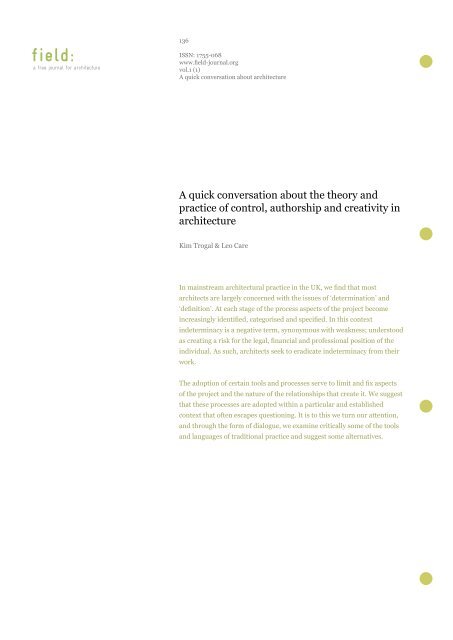
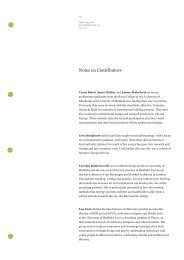
![ATLAS of Interdependence[889k] - field journal](https://img.yumpu.com/20827625/1/184x260/atlas-of-interdependence889k-field-journal.jpg?quality=85)
